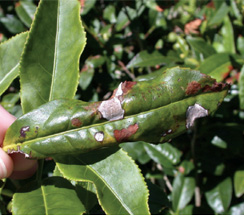Brown blight, grey blight: Colletotrichum sp., Pestalotiopsis sp.
Symptoms
- Small, oval, pale yellow-green spots first appear on young leaves.
- Often the spots are surrounded by a narrow, yellow zone.
- As the spots grow and turn brown or gray, concentric rings with scattered, tiny black dots become visible and eventually the dried tissue falls, leading to defoliation.
- Leaves of any age can be affected.
 |
 |
 |
 |
| Brown blight |
Grey blight |
Concentric rings |
Infected leaves |
Life Cycle
- The tiny, black spots on the lesions contain the fungal spores.
- Rain splash transports the spores from one plant or site of infection to another.
- If the spores land on a leaf, they germinate to start a new leaf spot or a latent infection.
Management
- Avoid plant stress.
- Grow tea bushes with adequate spacing to permit air to circulate and reduce humidity and the duration of leaf wetness.
- Spray Copper Oxy Chloride or Bordeaux mixture 0.1% during winter season and Summer season
Content validator:
Dr. M. Deivamani, Assistant Professor, Horticulture Research Station, Yercaud-636602.
Image source:
Keith, l., Ko, W.H and Sato D.M. 2006. Identification Guide for Diseases of Tea (Camellia sinensis). Plant Disease, 33, pp-1-4. |




